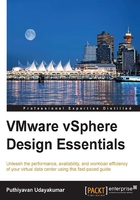
Designing ESXi
The VMware ESXi design comprises the fundamental OS and processes that run on top of ESXi, and it is called VMkernel. VMkernel runs all processes on ESXi, including ESXi agents, management software, as well as virtual machines. ESXi gains control over hardware devices on the physical servers and manages resources for the virtual machines. The main processes that route on top of the ESXi VMkernel are as follows:
- Direct Console User Interface (DCUI)
- Virtual Machine Monitor (VMM)
- Several agents used to enable high-level VMware infrastructure management from remote applications
- Common Information Model (CIM)

VMkernel is a POSIX-like OS developed by VMware and provides functionalities similar to other OS', such as control, process creation, process threads, signals, and filesystems. ESXi is designed precisely to support multiple VMs and provide core functionalities such as resource scheduling, I/O stacks, device drivers, and so on.
VMware ESXi was restructured to permit VMware consumers to scale out through a hypervisor that is more parallel to a hardware server. The vision was a base OS that is capable of autoconfiguring, receiving its settings remotely, and running from memory without disks. However, it's also an OS that's flexible enough to be installed on hard disks along with a locally saved state and user-defined settings for smaller, ready-to-use installations that don't require additional infrastructure.
Removing the VMware Service Console obviously has a great impact. A number of services and agents that were installed by default had to be rethought. The familiar command-line interface with its entree to management, troubleshooting, and configuration tools is swapped in ESXi, which is Linux-styled third-party agents for backups, hardware monitoring, and so on must be provisioned in different ways.